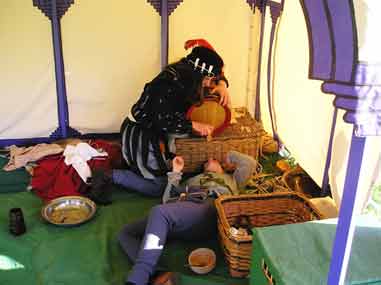| Archery |
| Brewing |
| Calligraphy & writing |
| Combat |
| Cooking |
| Dance |
| Etiquette |
| Household life |
| Medicine |
| Music |
| Needlework |
| Playacting |
| Religion |
| Storytelling |

Before the time of Henry VIII, brewing
was mostly done at home. The process consisted of mixing very hot water
and crushed malt to form a porridgy mash, which was then left for two
hours. During this time enzymes in the grain converted the starch into
sugars. The sugary liquid or wort as it is known was then run off and
cooled. Herbs such as mugwort, alecost, and alehoof were often added to
flavour it, and yeast was pitched to ferment it. More hot water was then
mixed with the grains to form a second and then third mash. The second
mash would make moderate strength ale, and the third would produce a very
weak beverage called 'small ale'. This would have been watery, hazy, and
full of impurities from the malt. Being only about one or two percent
ABV it would only keep at a week for the most, and was consumed in vast
quantities (about a gallon a day) as a safer alternative to water. The
first running of the malt would produce an astonishingly strong ale which
could keep for so long it would have time to clear, and was often saved
for celebrations. As all but the strongest of these beverages were prone
to spoilage after a short time, they were made in small quantities, often
at home. Monks brewed and drank vast amounts of strong ale, and all noble
households would have their own brewhouse. |